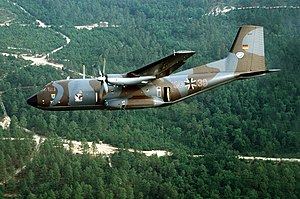C-160 Transall
| C-160 | |
|---|---|
 |
|
| C-160 of the German Air Force | |
| Role | Transport aircraft |
| National origin | France/Germany |
| Manufacturer | Transall |
| First flight | 25 February 1963 |
| Introduction | 1967 |
| Retired | South Africa 1997 |
| Status | Active service |
| Primary users |
German Air Force French Air Force Turkish Air Force |
| Produced | 1965–1985 |
| Number built | 214 |
|
|
|
|
|
The Transall C-160 (often C.160 or simply Transall) is a military transport aircraft, designed and produced as a joint venture between France and Germany. Transall is an abbreviation of the specially formed consortium Transporter Allianz, comprising the companies of MBB, Aerospatiale and VFW-Fokker. It was initially developed to meet the requirements for a modern cargo aircraft for the French and German Air Forces; export sales were also made to South Africa and to Turkey, as well as a small number to civilian operators.
The C-160 proved to be a long-lasting design, remaining in service more than 50 years after the type's first flight in 1963. It has provided logistical support to a number of overseas operations and deployments; and has also served in specialist roles such as an aerial refueling tanker, electronic intelligence and communications platform. The C-160 will be replaced in French and German service by the Airbus A400M Atlas.
In the late 1950s, a requirement arose to replace the piston-engined Nord Noratlas transports operated by both the air forces of France (Armée de l'Air) and Germany (Luftwaffe). Keen to encourage industrial co-operation between the two countries, as had happened under a previous arrangement in which Noratlases for German service had been built under license by Weser Flugzeugbau, France and Germany signed an agreement for the development of a Noratlas successor on 28 November 1957. The Italian government also became involved in the project early on to meet their own requirements, however Italy's participation in the fledging program was soon terminated in favour of a smaller and entirely domestically-built aircraft, the Fiat G.222.
A consortium, "Transporter-Allianz" or Transall, was formed in January 1959 between the French company Nord Aviation and the German companies Weser Flugzeugbau (which became Vereinigte Flugtechnische Werke (VFW) in 1964) and Hamburger Flugzeugbau (HFB) to design and build the new transport. The new aircraft was required to carry a 16,000 kilograms (35,000 lb) cargo over a range of 1,720 kilometres (930 nmi; 1,070 mi) or a load of 8,000 kg (18,000 lb) over a range of 4,540 km (2,450 nmi; 2,820 mi) and be able to operate out of semi-prepared airstrips. One prototype was built by each of the production partners, with the first (built by Nord) flying on 25 May 1963, with the VFW and HFB-built prototypes following on 25 May 1963 and 19 February 1964. These were followed by six pre-production examples, stretched by 51 centimetres (20 in) compared with the prototypes, which flew between 1965 and 1966.
...
Wikipedia
